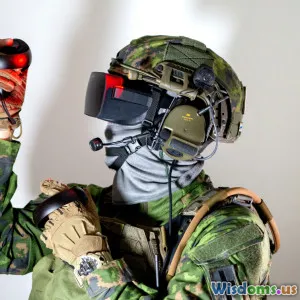
Five Predictions Shaping Antimissile Defense Systems By 2030
10 min read Explore five transformative predictions reshaping ant-missile defense systems by 2030, revealing future innovations in technology, strategy, and global security dynamics. (0 Reviews)
Five Predictions Shaping Antimissile Defense Systems By 2030
As we edge closer to 2030, the landscape of global defense is undergoing rapid transformation. Among the most critical facets is the advancement of antimissile defense systems, crucial for protecting nations against increasingly sophisticated threats. The progression of missile technology, including hypersonic weapons capable of evading traditional defenses, compels militaries around the world to innovate and adapt.
This article explores five transformative predictions that will shape the future of antimissile defense systems by 2030, from breakthroughs in artificial intelligence to revolutionary space-based interceptors. By understanding these shifts, defense strategists, policymakers, and security enthusiasts can better appreciate the complexities and innovations steering the next decade of missile defense.
1. Integration of Artificial Intelligence to Enable Rapid and Precise Decision-Making
Artificial intelligence (AI) is increasingly becoming a cornerstone technology in defense systems globally. For antimissile defenses, AI heralds a transformative impact on detection, tracking, and engagement processes.
Traditional missile defense systems rely heavily on human operators to analyze data and authorize intercepts—a process prone to delays and errors during critical moments. In contrast, AI enables real-time sensor data fusion, rapid threat classification, and automated command selections, all within fractions of a second.
For example, the U.S. Missile Defense Agency (MDA) has been investing heavily in AI-powered sensors and decision algorithms designed to analyze patterns in missile launches and predict trajectories with unparalleled accuracy. The implementation of AI-driven fire control systems allows multiple interceptor launches simultaneously while minimizing friendly fire risks and resource wastage.
A practical illustration comes from the integration of AI in the Aegis Combat System, where machine-learning algorithms support target discrimination, enhancing accuracy against complex threats such as decoys or multiple simultaneous missile launches. By 2030, advances in explainable AI—the ability to interpret AI decision pathways—will also ensure that commanders retain oversight and trust in these automated systems.
2. The Rise of Directed Energy Weapons as Primary Interceptors
Directional energy weapons (DEWs), such as high-energy lasers (HEL) and high-power microwave systems, are poised to revolutionize anti-missile engagements by offering near-instantaneous target neutralization without the need for physical interceptors.
Lasers, for instance, have matured rapidly due to progress in solid-state laser technology, enabling mobile and space-based platforms with sufficient power to disable or destroy incoming missile threats. The U.S. and China are in intensive competition to develop HEL systems that can operate day and night in varied atmospheric conditions.
A shining example is the American Army’s Integrated Battle Command System, which incorporates laser weapons for short-range missile defense with cost-per-shot significantly lower than traditional interceptors. Furthermore, directed energy weapons enable multiple engagements as long as power supplies are available, eradicating traditional logistic constraints.
By 2030, we can expect widespread deployment of HEL batteries on land, sea, and airborne platforms, supported by innovations in energy storage and beam control. Science fiction concepts such as star wars-era directed energy shields might mature into practical layers of missile defense.
3. Enhanced Sensor Fusion and Global Network Integration
Missile defense efficacy heavily depends on detection and tracking capabilities. Future interrogations of data sources promise an unprecedented level of 'sensor fusion'—the seamless integration of radar, infrared, satellite, and electro-optical sensors into unified battle networks.
The prediction is that by 2030, missile defense systems will be governed by a fully integrated global sensor commons, where assets from allied nations will contribute to and benefit from combined missile tracking information. For example, the cooperation between the United States’ Space Surveillance Network and partner nations can extend the horizon for early threat alerts by minutes or even hours.
The use of quantum radar technology is another cutting-edge development to overcome stealth measures deliberately built into modern missile systems. Quantum radars exploit quantum entanglement to detect objects with greater sensitivity and resistance to jamming.
Effective sensor fusion requires advanced cybersecurity protocols to ensure data integrity, given the potential for electronic attacks on communications. Future antimissile commands by 2030 will likely deploy AI-driven cyber resilience to maintain uninterrupted sensor networks.
4. Adapting to Hypersonic and Maneuverable Missile Threats
Perhaps the most daunting challenge for antimissile systems in the coming decade is countering hypersonic missile threats. These weapons fly at speeds exceeding Mach 5, with high maneuverability and low-altitude flight paths complicating traditional radar detection and interception.
Countries like Russia, China, and the United States are investing billions developing hypersonic glide vehicles (HGVs) and cruise missiles. To effectively neutralize such threats, antimissile systems must evolve beyond current kinetic interceptors.
One prediction is the implementation of multi-tiered defense architectures that sling-net sensors, AI processing, and rapidly-deployable interceptor units in layered constellations. Systems capable of preemptive threat tracking using space-based platforms will enhance detection windows.
Real-world experiments such as the U.S. Navy’s SM-6 missile modifications and DARPA’s Glide Breaker program demonstrate early attempts to create kinetic interceptors tailored to hypersonic flight profiles. By 2030, such programs may mature into operational defense layers capable of precise interception within seconds.
5. Emergence of Space-Based Interceptors as a Game-Changer
Space, often dubbed the 'ultimate high ground,' will be central to antimissile defense strategies by 2030. The deployment of space-based interceptor platforms capable of destroying ballistic missiles during their boost or mid-course phases significantly enhances the probability of successful engagements.
Current missile defense heavily relies on terrestrial and sea-based assets which are limited by horizon coverage and atmospheric interference. Space-based interceptors overcome these limitations with vantage points for early detection and direct engagement.
The U.S. Space Development Agency's plans to establish a layered constellation of sensors and potential interceptor satellites exemplify this transformative shift. Similarly, Russia and China are developing their own space-based missile defense capabilities as part of broader space militarization.
Concerns around weaponization of space underline the importance of establishing legal frameworks and international transparency to prevent destabilizing arms races. Nevertheless, the military advantages of space-based interceptors by 2030 seem undeniable.
Conclusion
The antimissile defense landscape by 2030 will be defined by radical technological innovations and strategic evolutions. Artificial intelligence is set to optimize rapid decision-making and threat discrimination, while directed energy weapons promise cost-effective, near-instant missile neutralization. Advanced sensor fusion will unlock holistic global awareness, critical for detecting increasingly stealthy and hypersonic missile adversaries.
Moreover, countering hypersonic threats demands cutting-edge layered defense architectures, combining terrestrial and space elements. Ultimately, the anticipated deployment of space-based interceptors stands to revolutionize how the international community addresses missile threats by raising early engagement capabilities beyond the atmosphere.
For policymakers, defense professionals, and global security advocates, embracing and guiding these developments with mindful investment, diplomacy, and cooperation will be vital. Failure to innovate or collaborate risks leaving nations vulnerable in a world where missile technologies are advancing swiftly.
Analyzing and preparing for these predictions helps shape a future where antimissile defense systems secure peace and stability amidst evolving military challenges.
Rate the Post
User Reviews
Other posts in Artificial Intelligence
Popular Posts


















